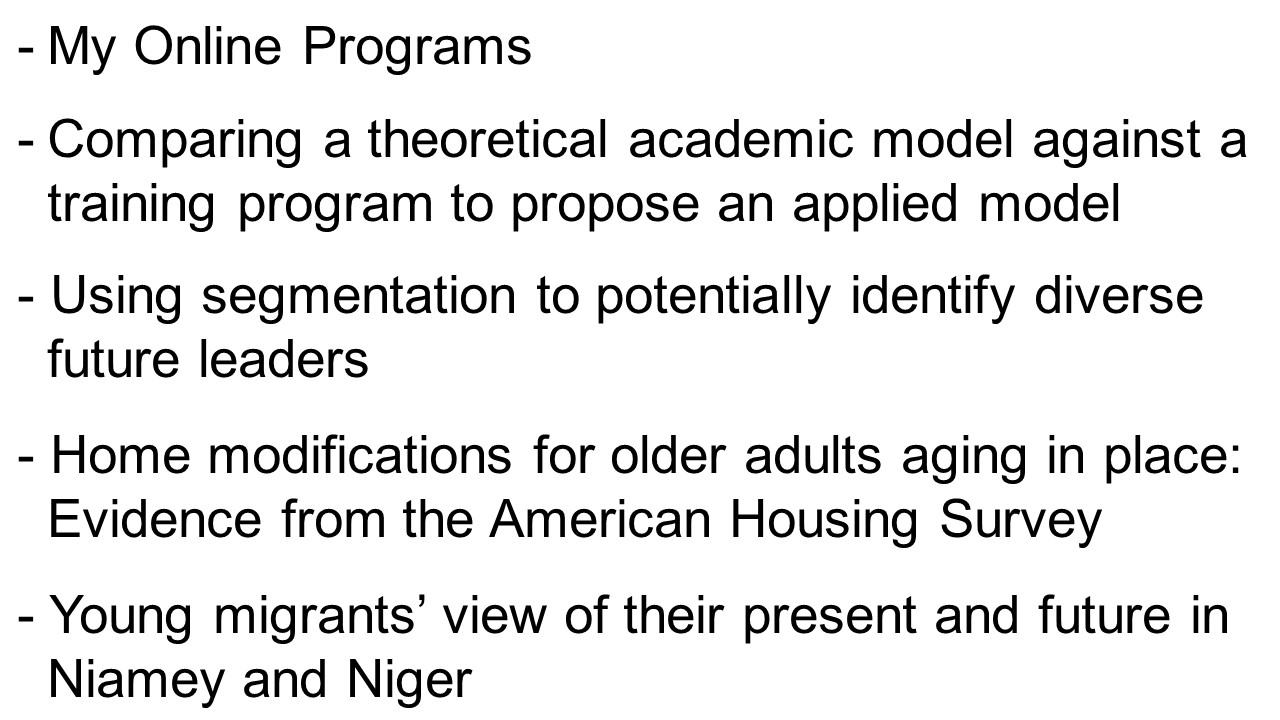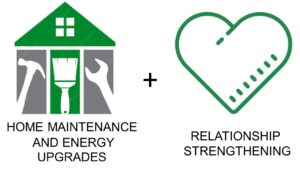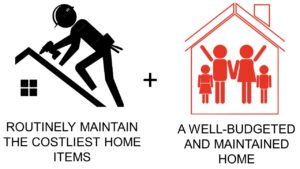My Online Programs and Publications

My Online Programs:

Click for: The Home Preventive Maintenance E-Calendar Tool

Recent Publications:
Cantrell, R., Vazquez, K., Leal, M.* (Accepted). Comparing a theoretical academic model against a training program dataset to propose an applied model. SN Social Sciences, 2(273), 18 pps. https://doi.org/10.1007/s43545-022-00587-2
This study examined the three constructs of, Homeflow, a 2013 theoretical academic model that depicts how the home can be physically altered along with its occupants’ behaviors to affect a household’s/family’s finances, time, and community engagement. A dataset recently was collected from 196 individuals who participated in a currently offered applied training program, based on the 2013 Homeflow model, which was called the Homeflow Applied Training Program. This study assesses the “fit of that Training Program against the theoretical model. Multiple regression analysis showed that constructs from the theoretical model (i.e., Maintenance, Family Operations, and Light Mechanical), when estimated using pre- and post-test data from the Training Program, remained statistically significant, accounting for 75.8% of the variance explained by the regression equation. However, Family Operations and Light Mechanical, explained substantially less variance than Maintenance did in the theoretical model. Implications are that those participants who were most confident about how to apply what they learned in the Training Program, specifically as it pertained to the reasons why it was important to safely organize the interior of their residence while also maintaining its exterior, demonstrate that most all home occupants can contribute to the residence’s overall maintenance at some level. However, when it comes to: 1) how the family operates, and 2) conducting light mechanical repairs/upgrades, that requires more of a “seasoned,” motivated home occupant to achieve those levels of stability within a residence.
Cantrell, R., Suarez, C., Vazquez, K., and Jones, J. (2022). Using segmentation to potentially identify diverse future leaders. SN Social Sciences, 2(28), 27 pps. https://doi.org/10.1007/s43545-022-00329-4
This exploratory study’s contribution offers predictors that potentially identify diverse future leaders. Its motivation stems from ambiguous research regarding how leaders ultimately rise to their positions. Using a segmentation strategy, a sample of 1943 participants in the Southeast and mid-Atlantic United States was grouped according to its views regarding future leadership. The segmentation strategy was used to level the “playing field” so all qualified candidates, regardless of their socio-economic status, have equitable opportunity to potentially receive leadership train-ing. (The playing field is where those with advantaged socioeconomic status are trained for leadership programs while those without such status rarely receive these opportunities.) The unit of analysis is those who self-report viewing themselves as less likely to potentially be identified as future leaders. Understanding their view-points helps to posit ways for these unlikely leaders who possess much talent to potentially become involved in leadership programs. If identified, candidates representative of this diverse segment could potentially become future leaders. Differences emerged between groups (e.g., education, current behaviors, past/current beliefs, expected future behavior), comprising independent variables for multiple regression to “Potentially Identify Diverse Future Leaders.” The regression equation predicted 57.1% of the explanation in variance regarding this dependent variable for the segment of interest. Though perhaps thought to be obvious by some, this research reinforces the notion that this segment of potential leaders needs to be nurtured carefully regarding beliefs in its future role pertaining specifically to the workplace and its general view of the future as a whole.
Green, L., Betz-Hamilton, A., Albright, B., Lee, S., Vasquez, K., Cantrell, R., Peek, G., and Carswell, A. (2022). Home modifications for older adults aging in place: Evidence from the American Housing Survey. Journal of Aging and Environment, doi: 10.1080/26892618.2022.2140466
What is the impact of housing adequacy on recent home modification, controlling for demographics and housing characteristics? This study examined home modifications of households with a member aged 65 or older, focusing on relationships between selected demographic and housing variables and home modification. Binary logistic regression analysis was used on a sample of 6,627 homeowners from the newly released 2019 American Housing Survey (AHS) dataset. This analysis of the 2019 AHS data is important because of its pre-COVID pandemic era perspective in terms of home modifications and older adults aging in place. Results showed that recent housing modifications were significantly affected by select demographic and housing factors.
Cantrell, R., Yaye, M., Hungerford, H., Forthun, L., Irani, T., Cantrell, V. (2021). Young migrants’ views of their present and future in Niamey and Niger. SN Soc Sci, 1(134), 1-20, DOI https://doi.org/10.1007/s43545-021-00150-5
The Author(s), under exclusive license to Springer Nature Switzerland AG 2021AbstractMigration often involves younger individuals departing home for another location to earn money. This study’s contribution is that it show how migrants, who are part of Niger’s youth majority, desire to be part of its economy. However, they lack formal background with business and social networks, which are both pivotal components for future success. Thus, they could find themselves at risk of being marginalized or having to return to their villages. An exploratory case study strategy was used to investigate what life is like for these young migrants. Personal interviews were con-ducted via semi-structured surveys. Two over-arching questions regarding respondents’ progress toward accomplishing shorter- and longer-term goals associated with migrating were offered via literature-generated prompts related to residential experiences, home/security/support, migratory habits, work/income, and person identity. On average, respondents’ age was 25 years, had lived in Niamey six years, and relocated annually. They earned enough to make a meager living while sometimes also earning some savings, sending some money back to the family in the village, or attempting a slight combination of the two options after paying for their living expenses. They contemplated marriage, family, and community, but most did not consider themselves as citizens who would one day become established community members, impacting the future. “A need to have hope for the future” was a major theme that resonated with most of the respondents. Although not representative of this study’s theme, suggestions regarding possible future policy inquiry are offered as thought-provoking points of insight for consideration.